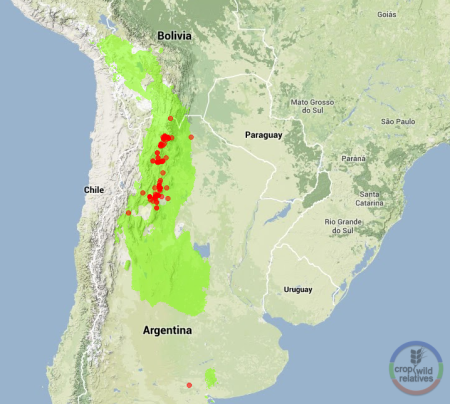![]() You may have been following the reaction to the media frenzy about the announcement yesterday of a new way of making potatoes resistant to blight, cause of the Irish Famine a century and a half ago. I won’t add to the confusion, beyond saying that, as in everything in life, there are always alternatives, and wouldn’t it be nice if we gave them all a fair go?
You may have been following the reaction to the media frenzy about the announcement yesterday of a new way of making potatoes resistant to blight, cause of the Irish Famine a century and a half ago. I won’t add to the confusion, beyond saying that, as in everything in life, there are always alternatives, and wouldn’t it be nice if we gave them all a fair go?
No, what I want to talk about here is where the gene in question came from, the gene for blight resistance that was inserted into the popular British variety Desiree to such apparently good effect. We know from the paper that the gene is called Rpi-vnt1.1 and that it came from the potato wild relative Solanum venturii, but that’s all. I think that’s insufficient. There may be a reference in the paper or the supplementary material ((Jonathan D. G. Jones et al. (2014). Elevating crop disease resistance with cloned genes. Phil. Trans. R. Soc. B DOI: 10.1098/rstb.2013.0087)) to the source of the Solanum venturii germplasm that was used in this work, but I was unable to find it. Apologies to the authors if I missed it, and thanks to whoever it was at the Sainsbury Lab that tweeted a response to my request for information:
@AgroBioDiverse @Cipotato Seed was from: http://t.co/XLC5Ud82mh
— The Sainsbury Laboratory (@TheSainsburyLab) February 17, 2014
It turns out that the germplasm was obtained from the Centre for Genetic Resources, the Netherlands, which has often been mentioned on this blog. Most recently, as coincidence would have it, yesterday, and on the subject of potatoes to boot. CGN is at the very forefront of genebank documentation, so it was very easy to find that there are 3 accessions of the species in question at CGN, that only one of those is resistant to blight, that it is CGN18000, that it was collected in 1972 in Argentina at an elevation of 3200m and that it came to CGN via the Institut fur Pflanzenbau und Pflanzenzuchtung Bundesforschungsanstalt, Braunschweig, Germany. There are more accessions out there (although apparently not at CIP, the International Potato Center, at least according to Genesys), and also herbarium specimens. Enough in fact to come up with an estimate of the overall geographic distribution of S. venturii, and perhaps identify some gaps.
Or am I wrong? It’s an informed guess. If there had been more than one accession with resistance, it would have been difficult to know which one was actually used in the paper. Anyway, I look forward to the day when even the authors of whizz-bang biotech papers will spend five minutes to do what I just did and properly acknowledge, perhaps even link to, the genebank, and the specific accession, whose existence ultimately allowed them to do their work.

Hi,
Apologies, a previous tweet from ourselves erroneously confirmed the accession as CGN18000. It is in fact CGN18108 which is still listed in the database as Solanum okadae (was subsequently found to be S. venturii in DNA fingerprinting studies).
The origin of Rpi-vnt1 is detailed in the original research paper describing the cloning and characterisation of the gene and which is cited in the Roy. Soc. paper published yesterday. All acknowledgement of sources was published in that paper.
Foster SJ, Park T-H, Pel M, Brigneti G, Sliwka J, Jagger L, van der Vossen E, Jones JDG. 2009 Rpi- vnt1.1, a Tm-2(2) homolog from Solanum venturii, confers resistance to potato late blight. MPMI 22, 589 – 600. (doi:10.1094/MPMI-22-5-0589)